1
What do I need to know how to do?
What Tools do I need?
First, verify that your components are tubeless compatible. See Tubeless Tire Compatibility for more information on tubeless tire standards.
3
There are two main methods for adding sealant to the tire:
This method requires a measuring cup. An air compressor is highly recommended.
This method requires a valve with a removable valve core, a syringe, and an air compressor.

Sealant seeping through the tire bead
The rim strip on this wheel was not adequately sealed. Sealant may, in time, create a seal
4
In general, punctures in tubeless tires cannot be repaired. Punctures in UST tubeless tires, and other tubeless tires with a butyl inner lining, can potentially be repaired using a vulcanizing patch kit such as the VP-1. It is not recommended that you attempt to use other types of patches, or attempt to repair other types of tubeless tires.
It is not recommended that you attempt to use other types of patches, or attempt to repair other types of tubeless tires.
See Inner Tube Repair for instructions on using a vulcanizing patch kit.
It’s pretty rare to get a flat tire when you have a tubeless setup. The sealant inside your tires will quickly seal small holes and cuts to keep you rolling on the road or trail. However, flats are always possible – even with tubeless. Whether you’ve discovered your tire is flat after storing it in the garage, or you lose pressure after a sudden impact with a rock, we have you covered with the tips you need. Check out our guide to fixing your tubeless flat and getting back out on your ride.
You also might need:

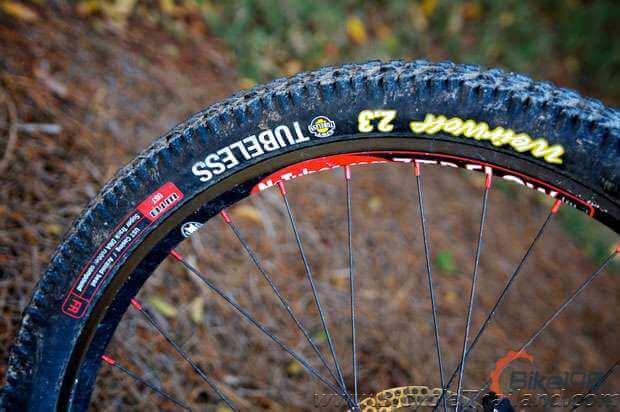
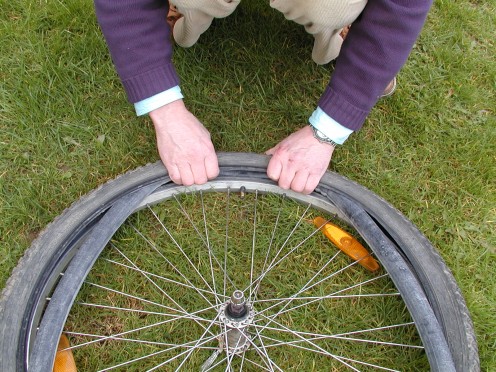
PRO TIP: Opt for plastic tire levers over metal ones. They won’t scratch the surface of your rim and they are lighter and easier to carry!
 If you find a large hole or gash in the tire that cannot be fixed with sealant alone, you’ll need to patch the tire and you might even need to install a tube until you arrive home.
If you find a large hole or gash in the tire that cannot be fixed with sealant alone, you’ll need to patch the tire and you might even need to install a tube until you arrive home.PRO TIP: If the last bit is super tight, start back at the top and use your hands to wiggle the tire into the center of the rim. Just like you did at the beginning to loosen the bead from the rim, this creates extra slack in the tire and will make it easier to get onto the rim. While you wiggle the tire push down. When you get to the bottom, you might be able to pop that tire on with your bare hands!

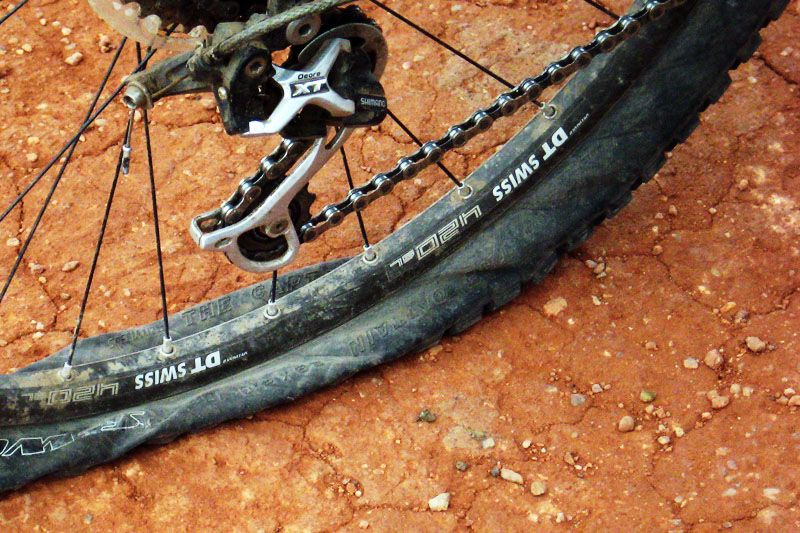 Then, just give it a spin and squeeze your brake to make sure everything works like it should. Nice job!
Then, just give it a spin and squeeze your brake to make sure everything works like it should. Nice job!How to Choose the Right Saddle
How to Store Multiple Bikes and Gear in Small Spaces
How to Adjust Your Suspension on the Trail
How to Adjust a Dropper Post
How to Set Up Mountain Bike Suspension
Get Your Printable Fix-a-Flat Zine
How to Fix a Flat Tire | Tubeless
How to Fix a Flat with a Tube
Top Five Bike Maintenance Tips
What to Pack for an Epic Mountain Bike Ride
How I Became a Professional Bike Mechanic
How to Use a Torque Wrench
How to Select Mountain Bike Tires
How to Select Road Bike Tires
How to Perform a Safety Check on Your Bike
The Importance of Proper Bike Fit
How to Prep Your Bike for Riding in the Rain
How to Replace Disc Brake Pads and Rotors
How to Cut MTB Handlebars
Trailside Bike Repair Fix Guide
How to Setup Tubeless Tires
How to Silence Common Bike Noises
How to Replace Handlebar Tape on a Road Bike
How to Pack and Ship a Bike
How to Wash a Bike
How to Adjust a Bike Derailleur
How to Repair a Broken Bike Chain
How to Make a Wall-Mounted Shelf to Hang your Bike
How to Make a Bike Hook out of Pipe Fittings
How to Carry a Yoga Mat on a Bike
Removing and Reinstalling a Bike Wheel for Transport
How to Navigate the Subway with a Bike
How to Lock your Bike in a City
Parts of the Bike
How to Fix Squeaky Disc Brakes
Bike Safety | Hand Signals and Riding Tips
Cycling at Night: How to Light Up Your Bike
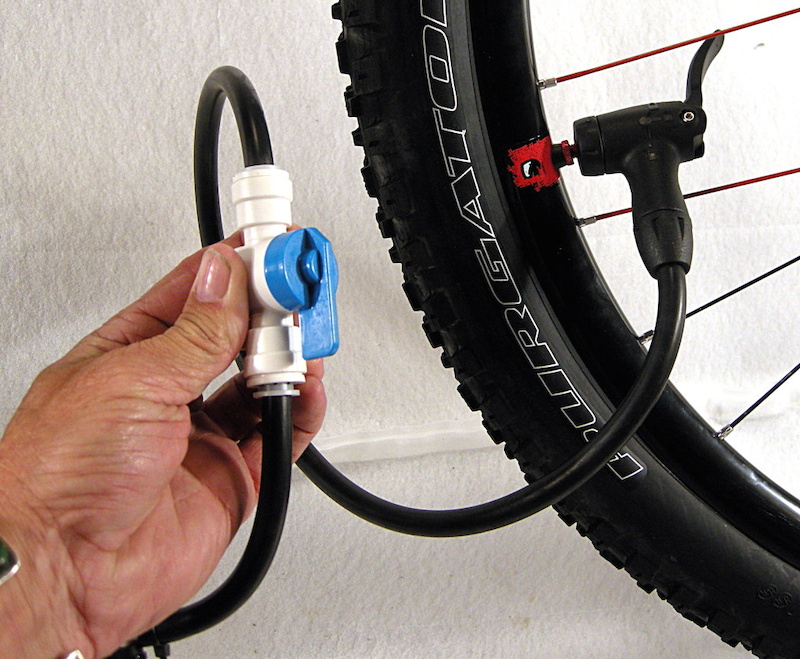 Operating tubeless tires
Operating tubeless tires In addition to the rim and TR tires, you will need:
First of all, you need to forget about the use of beads, as they can damage the tires. We do everything with our fingers.
1 All manipulations are carried out on an already assembled wheel. First we need to seal the rim. To begin with, we clean and degrease the rim. Since the holes for the nipples sometimes have burrs and can damage the yellow tape, we check the holes on the rim and grind the burrs with a file (most likely they will not be there). Then we wipe the rim over the entire diameter with a zero, degrease it with alcohol or another liquid and wipe it dry. Attach yellow tape. At the same time, we stretch the tape, we are not afraid to apply force, be sure to pass the central groove so that the tape fits into it. We start gluing 7 - 10 mm from the hole for the nipple with the expectation that it will be glued twice. We cut the tape and pierce the hole for the nipple with an awl. In order not to crush the seals, tighten the valve without using any tools. Then lubricate the rim from the inside and the heel of the tire from the outside with a special fluid designed for installing tubeless tires. Also, instead of this liquid, you can use a solution of water and soap. First we need to seal the rim. To begin with, we clean and degrease the rim. Since the holes for the nipples sometimes have burrs and can damage the yellow tape, we check the holes on the rim and grind the burrs with a file (most likely they will not be there). Then we wipe the rim over the entire diameter with a zero, degrease it with alcohol or another liquid and wipe it dry. Attach yellow tape. At the same time, we stretch the tape, we are not afraid to apply force, be sure to pass the central groove so that the tape fits into it. We start gluing 7 - 10 mm from the hole for the nipple with the expectation that it will be glued twice. We cut the tape and pierce the hole for the nipple with an awl. In order not to crush the seals, tighten the valve without using any tools. Then lubricate the rim from the inside and the heel of the tire from the outside with a special fluid designed for installing tubeless tires. Also, instead of this liquid, you can use a solution of water and soap. | |
2, 3 - first, the first bead of the tire is placed inside the rim, and then carefully the second bead.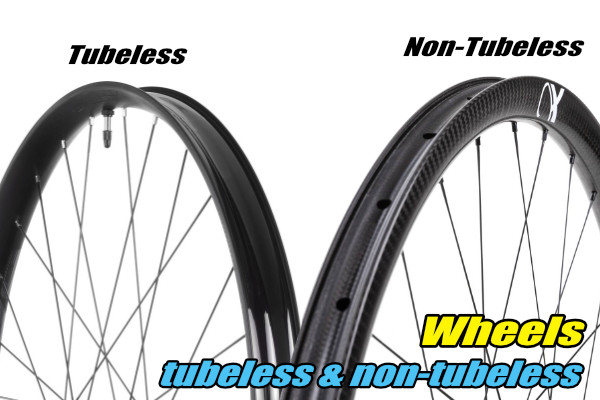 You have to work consistently and slowly. You have to work consistently and slowly. | |
| 4, 5 - after installing both beads into the rim, the tire is inserted entirely into the rim and simultaneously straightened with a smooth circular motion of the hands. | |
6 Then we insert the tube, pull the tire onto the rim (it will be tight, it will fit both sides into the central groove on the rim, and the heel zones of the tire will be located close to the inner cavity of the rim). Loading up the camera. You can usually skip this step, but we need it in order to properly press the yellow tape to the rim with the camera and level it. In addition, we can see how the tire sits on the rim, which at the stage of installation with sealant will greatly simplify your life. As the tire sits tight, it may become crooked at first. That is, part of the bead cord of the tire will become as it should be under the bead of the rim, and the other part will remain in the central groove and, regardless of the force applied, it will not want to move into place.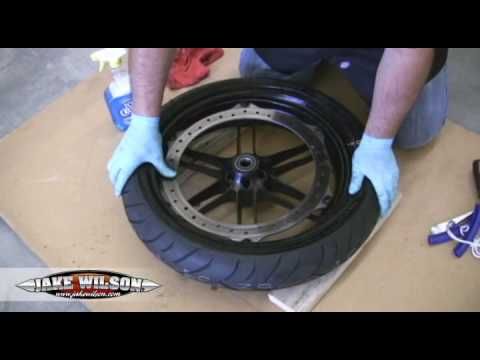 To correct this situation, we pump air to the pressure recommended by the manufacturer or a little more. It's different for every tire width. A loud sound will indicate that the tire bead has popped out of the center groove and snapped into place against the rim bead. If even now the tire has not become even, then you can help it to fall into place with your hands. If you want the labels on the tire to match the stickers on the rim, then pre-tighten the tire evenly, because after you have tensioned at least one side, it will be very, very difficult to dislodge the tire. In this state, the wheel should be left for a day or several hours and you can start pouring tire sealant. We release air from the chamber. In the process of pressure drop, one or the beads may slip into the central groove. In the ideal case, one side remains in place, and we dismantle the slipped side. We take out the chamber, screw the nipple into place and fill in the sealant for tubeless tires. The amount of sealant depends on various conditions - I would recommend 100 grams. To correct this situation, we pump air to the pressure recommended by the manufacturer or a little more. It's different for every tire width. A loud sound will indicate that the tire bead has popped out of the center groove and snapped into place against the rim bead. If even now the tire has not become even, then you can help it to fall into place with your hands. If you want the labels on the tire to match the stickers on the rim, then pre-tighten the tire evenly, because after you have tensioned at least one side, it will be very, very difficult to dislodge the tire. In this state, the wheel should be left for a day or several hours and you can start pouring tire sealant. We release air from the chamber. In the process of pressure drop, one or the beads may slip into the central groove. In the ideal case, one side remains in place, and we dismantle the slipped side. We take out the chamber, screw the nipple into place and fill in the sealant for tubeless tires. The amount of sealant depends on various conditions - I would recommend 100 grams.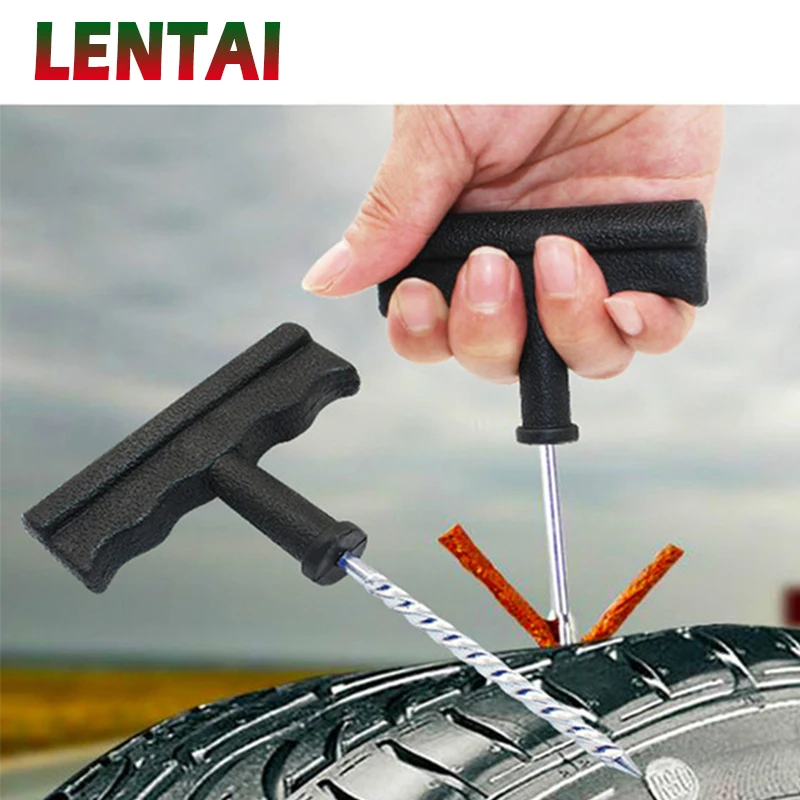 Before pouring the sealant, we board the tire about 3/4 of its circumference with the nipple up. It would be nice if someone could help you. One person holds the wheel and tire to keep the bead from slipping off the rim while a second person measures and pours the sealant. If you still have to work on your own, then it’s better to hang the wheel, because it’s wrong to pour sealant into a wheel that is on the ground with disassembled rubber. In order not to try to measure the sealant with the help of a container, we hang the jar of sealant on a conventional electronic kitchen scale, remember the weight and pour it until it comes out approximately 100 grams less when weighing again. So you kill two birds with one stone, firstly, you know exactly how much sealant is filled in (a few grams will still run away during sealing), and secondly, you know how much the weight of your bike has increased. Filling the sealant, we begin to bead the tire. The bead slides into the center groove and prevents sealant from escaping from the side. Before pouring the sealant, we board the tire about 3/4 of its circumference with the nipple up. It would be nice if someone could help you. One person holds the wheel and tire to keep the bead from slipping off the rim while a second person measures and pours the sealant. If you still have to work on your own, then it’s better to hang the wheel, because it’s wrong to pour sealant into a wheel that is on the ground with disassembled rubber. In order not to try to measure the sealant with the help of a container, we hang the jar of sealant on a conventional electronic kitchen scale, remember the weight and pour it until it comes out approximately 100 grams less when weighing again. So you kill two birds with one stone, firstly, you know exactly how much sealant is filled in (a few grams will still run away during sealing), and secondly, you know how much the weight of your bike has increased. Filling the sealant, we begin to bead the tire. The bead slides into the center groove and prevents sealant from escaping from the side. | |
7, 8 Turn the wheel a little by hand so that the sealant spreads evenly and pump it up with a high-quality floor pump that is able to create sufficient pressure. Since the tire sits tight, even at the very beginning the air loss will be insignificant, we pump up the air and wait until the bead falls into place. We recognize this moment by the loud sound of rubber hitting the rim flange. Along the way, you need to check for any bubbles of liquid or soapy water for installation, which may indicate the presence of gaps between the walls of the rim and the tire. Take the wheel in both hands and shake it in all directions to seal small holes - if the tires are of good quality, then this process will be quick. We put the wheels on the bike and go for a ride. At first, it is possible that the tire will lose pressure - this is a slow process, but in 2-3 days the pressure can drop by one atmosphere. This problem can be solved by disassembling, draining the sealant and washing the inside of the tire with a brush and soap. In the middle, the tire is specially treated with a substance due to which the sealant does not stick, but flows down. As for me, if you ride actively, then the tire can be simply periodically pumped up every three to four days. If the installed tire still strongly poisons the air, then it must be strongly rubbed with a solution of laundry soap. For better spreading of the sealant, sometimes the tire inside can be lubricated with an alcohol solution. When the sealant is completely dry and does not cope with small punctures, it can be sealed with 88-m waterproof rubber adhesive. Similarly, you can seal tires with defective sidewalls or holes that the sealant cannot seal in any way. A tire that is torn or cut during operation must be cleaned of sealant, sealed with a patch for cameras and reinstalled. If the sealant has not dried, it can be reused. In the middle, the tire is specially treated with a substance due to which the sealant does not stick, but flows down. As for me, if you ride actively, then the tire can be simply periodically pumped up every three to four days. If the installed tire still strongly poisons the air, then it must be strongly rubbed with a solution of laundry soap. For better spreading of the sealant, sometimes the tire inside can be lubricated with an alcohol solution. When the sealant is completely dry and does not cope with small punctures, it can be sealed with 88-m waterproof rubber adhesive. Similarly, you can seal tires with defective sidewalls or holes that the sealant cannot seal in any way. A tire that is torn or cut during operation must be cleaned of sealant, sealed with a patch for cameras and reinstalled. If the sealant has not dried, it can be reused. |
1 - remove the cap and bleed the air from the tire. | |
| 2, 3 - Carefully place the heel area of the tire into the center cavity of the rim. | |
| 4 - with a smooth circular motion of the hands, we install the entire heel zone of the tire into the central cavity of the rim. | |
| 5, 6 - move the heel area of the tire beyond the rim wall. The second heel zone is located at the opposite wall of the rim. | |
| 7, 8 - slightly turning the tire, remove it from the rim. |
Many cyclists have become accustomed to the telltale hissing sound coming from tires. At any moment, your high-tech mountain bike can be put out of action by a simple thorn or a small piece of pebble.
Since the advent of pneumatic tires, this problem has haunted cyclists, tiring with the frequency of punctures and the amount of work needed to fix them. And only recently, bicycle tire and rim manufacturers have decided to create a universal tubeless system (UST).
And only recently, bicycle tire and rim manufacturers have decided to create a universal tubeless system (UST).
This system is a sealed rim in which the holes for the spokes and the nipple are completely airtight. Also, the non-porous rim sidewalls have improved grip on tire walls that are thicker than conventional tires. During tire inflation, air presses the tire bead (lower edge of the sidewall) into the corresponding groove in the rim flange, thereby sealing the contact between the tire and the rim.
Theoretically, the advantages of a tubeless tire include low weight (due to the lack of a tube, although tubeless tires are heavier than conventional tires), less pressure (providing better grip) and the absence of pinch punctures (also known as "snake bites"). If you add some sealant to the system, then penetrating punctures will also be a thing of the past.
But what about a cyclist who has conventional rims without sealing? Just buy a conversion kit, tubeless or Tubeless Ready tires and he can send his bike tubes to the dustbin of history.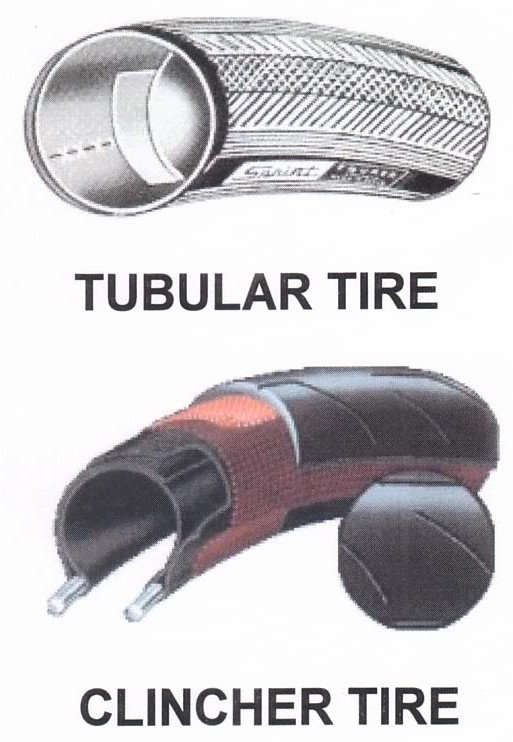
Of course, you can only add sealant to a conventional chamber. In this case, you won't gain any weight or grip advantage, just add a little weight to the wheels, but it will help you avoid punctures and not spend money on new tubeless tires and a tubeless conversion kit. Read our guide to using Gremetic in chambers.
Remove the wheels, tires and tubes from the bike. If the wheels are old, greasy and dirty, clean them with hot soapy water or alcohol. The rubber band will need to be taped to the spoke bed on the rim, so the rim needs to be clean and free of dirt so that the band fits snugly.
 Check the rim tape.
Check the rim tape. Take the rim tape and unfold it so that the nipple is on the inside of the tape. Run your fingers around its circumference and check it for cuts, nicks, bulges, and proper molding that could cause air to leak. Even if the tire drops a few psi in a day, it can be very annoying.
Position the part of the rim tape with the nipple in the spoke bed, carefully push the end of the nipple through the hole provided for it and pull it out the other side. The piece of tape near the nipple is slightly thicker and therefore difficult to install correctly, but it is important to install it correctly now so that you do not have to look for the source of leaks later.
Next, you need to install the remaining section of the rim tape in the spoke bed. This is easier said than done as the tape is tight against the rim. The easiest way to install it is with a screwdriver with a long thin handle. Position the screwdriver perpendicular to the rim between the rim and the rim tape. Slowly moving the screwdriver around the circumference of the rim, set the rubber band evenly in the spoke bed.
Position the screwdriver perpendicular to the rim between the rim and the rim tape. Slowly moving the screwdriver around the circumference of the rim, set the rubber band evenly in the spoke bed.
First of all, make sure you have a working nipple that does not let air through. Most nipples have a special threaded lock washer that screws onto the nipple body. The nipple usually comes with a rubber o-ring that needs to be installed between the lock washer and the rim. By flattening the O-ring, you will create an additional seal on the outside of the hole.
Now that the rubber rim is in place and in the center of the rim, you need to check the uniformity of its tension throughout the entire length of the rim. Air can leak between the rim and the rim tape if there are loose or tight areas on the tape. Again go around the rim with a screwdriver and equalize the tension of the tape. This will take a few minutes.
Tires from different manufacturers or even different models from the same manufacturer differ in the complexity of installation, their quality and other characteristics. If the tires were not installed on the wheel, then first install them as usual with tubes, inflate to the maximum recommended pressure and leave them overnight. After that, they will be much easier to install and pump.
Place the wheel on your feet so that the valve is at the highest point of the wheel (12 o'clock). First, place the tire beads near the nipple, then walk with both hands around the circumference of the tire (in different directions), loosening the bead over the rim wall along the way. Once you get to the very bottom of the wheel, leave an 8-inch section.
Some sealants can be applied without removing the nipple core, the spring-loaded piece that screws into the nipple body and allows air to enter the tire without escaping, but most cannot. Sludge Sealant can be injected without removing the core of the nipple. Removable core nipples are included in many conversion kits, but not all. The core must be unscrewed and removed. Be careful not to lose it as it can easily roll over furniture on the floor. If you have a nipple without a core to be removed, then immediately go to step 12.
Sludge Sealant can be injected without removing the core of the nipple. Removable core nipples are included in many conversion kits, but not all. The core must be unscrewed and removed. Be careful not to lose it as it can easily roll over furniture on the floor. If you have a nipple without a core to be removed, then immediately go to step 12.
Now that you have completely seated the tire on the rim and removed the core of the nipple, you can inject the required amount of sealant into the tire using the narrow line nozzle. Shake the sealant bottle well before doing this.
After the sealant has been poured through the nipple, screw the nipple core back on. Before screwing in the core, it is recommended to lubricate its threads with petroleum jelly, which will reduce the likelihood of jamming of the core or difficulty in turning it.
If you don't want to or can't apply sealant through the nipple, leave a small section of the tire bead exposed on the rim and pour sealant through it. Use a bottle with a nozzle to infuse the sealant, as a natural rubber tire is difficult to keep its shape. Suspend the wheel carefully so as not to spill the sealant from the tire.
Use a bottle with a nozzle to infuse the sealant, as a natural rubber tire is difficult to keep its shape. Suspend the wheel carefully so as not to spill the sealant from the tire.
To install the last section of the tire, carefully rotate the wheel so that the uninstalled section is on top. Now you can let the sealant spread all over the tire. Do not worry if a little sealant still leaks.
Start inflating the tires with the car pump until the tire beads press against the rim. When the pressure is too high (about 60 - 80 psi for UST tires and Tubeless Ready tires), the tire beads should click into place with a characteristic "clicking" sound. Be careful when handling this high pressure. Your tires are now tubeless.
Air can escape between the rim and tire. Raise the wheel, take it by the tire like you are holding a tray. Shake the wheel well so that the sealant spreads throughout the tire, reacts with the air and creates a thick sealing layer. Even if you skip this step, over time, the sealant will still spread on its own. Leave the wheel for 15 minutes, then repeat this step again. Air leakage should stop.
Even if you skip this step, over time, the sealant will still spread on its own. Leave the wheel for 15 minutes, then repeat this step again. Air leakage should stop.
Hold the wheel up to your ears and listen carefully for air leaks. If a leak is found, then it is most likely a microscopic hole. Repeat step 15 and/or add more sealant.
The carcass of the UST tire is impregnated with special rubber to retain air. Tubeless Ready tires have thinner walls, which means they are lighter and less airtight.) They have a dockable bead needed to install them as tubeless. At the same time, Tubeless Ready tires can only be used as tubeless tires in conjunction with liquid sealant, but we still recommend buying UST tires. Theoretically, with the help of sealant, you can use both tubeless and conventional tires, but they can only be installed correctly by trial and error.
